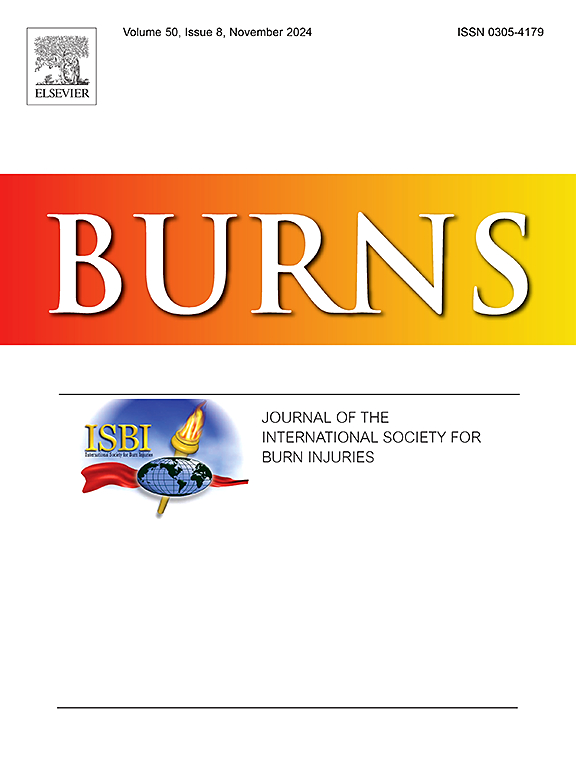治疗性讲故事对烧伤敷料患儿疼痛、恐惧和焦虑水平的影响。
IF 2.9
3区 医学
Q2 CRITICAL CARE MEDICINE
引用次数: 0
摘要
目的:本研究旨在评估治疗性讲故事对接受烧伤敷料手术的儿童疼痛、焦虑、恐惧、生理参数、父母焦虑和满意度的影响。方法:于2023年4月至2024年6月对伊斯坦布尔某医院烧伤科的60名儿科患者及其父母进行随机对照试验。参与者被随机分为两组:干预组(n = 30),在烧伤敷料期间听取数字化治疗故事,对照组(n = 30),接受标准治疗,不进行额外干预。采用描述性特征表、儿童焦虑量表、儿童恐惧量表、Wong-Baker疼痛量表、父母满意度量表、状态-特质焦虑量表和生理参数表收集数据。结果:患儿平均年龄为3.96 ± 0.99岁;53.3% %为男性,83.3% %为核心家庭。与对照组相比,讲故事组的儿童在手术期间和手术后的疼痛、焦虑和恐惧水平明显降低(p 0.05)。结论:以数字格式聆听治疗性故事可有效减少儿童烧伤敷料过程中的疼痛、焦虑和恐惧,改善生理参数,提高家长满意度。这是一种简单、快速、成本效益高的基于艺术的方法,护士可以在烧伤敷料过程中使用最少的设备和准备。本文章由计算机程序翻译,如有差异,请以英文原文为准。
The effect of therapeutic storytelling on pain, fear, and anxiety levels in children undergoing burn dressing
Aim
This study aimed to assess the impact of therapeutic storytelling on pain, anxiety, fear, physiological parameters, and parental anxiety and satisfaction levels in children undergoing burn dressing procedures.
Methods
A randomized controlled trial was conducted between April 2023 and June 2024 with 60 pediatric patients and their parents in the burn unit of a hospital in Istanbul. Participants were randomized into two groups: the intervention group (n = 30), who listened to a digitized therapeutic story during burn dressing, and the control group (n = 30), who received standard care without additional intervention. Data were collected using the Descriptive Characteristics Form, Child Anxiety Meter-State, Child Fear Scale, Wong-Baker Pain Scale, Parental Satisfaction Scale, State-Trait Anxiety Scale, and a Physiological Parameters Form.
Results
The mean age of the children was 3.96 ± 0.99 years; 53.3 % were male, and 83.3 % lived in nuclear families. Children in the storytelling group experienced significantly lower pain, anxiety, and fear levels during and after the procedure compared to the control group (p < 0.001). In the intervention group, anxiety levels progressively decreased from before to after dressing (p < 0.001), while fear and anxiety in the control group increased during the procedure but decreased afterward. Significant differences were observed between the groups in pulse rate, systolic, and diastolic blood pressure across all dressing stages (p < 0.001), whereas oxygen saturation levels showed no significant difference (p > 0.05).
Conclusion
Listening to therapeutic stories in a digital format effectively reduced pain, anxiety, and fear during burn dressing in children, improved physiological parameters, and enhanced parental satisfaction. This is a simple, fast, and cost-effective art-based method that nurses can apply during burn dressing with minimal equipment and preparation.
求助全文
通过发布文献求助,成功后即可免费获取论文全文。
去求助
来源期刊

Burns
医学-皮肤病学
CiteScore
4.50
自引率
18.50%
发文量
304
审稿时长
72 days
期刊介绍:
Burns aims to foster the exchange of information among all engaged in preventing and treating the effects of burns. The journal focuses on clinical, scientific and social aspects of these injuries and covers the prevention of the injury, the epidemiology of such injuries and all aspects of treatment including development of new techniques and technologies and verification of existing ones. Regular features include clinical and scientific papers, state of the art reviews and descriptions of burn-care in practice.
Topics covered by Burns include: the effects of smoke on man and animals, their tissues and cells; the responses to and treatment of patients and animals with chemical injuries to the skin; the biological and clinical effects of cold injuries; surgical techniques which are, or may be relevant to the treatment of burned patients during the acute or reconstructive phase following injury; well controlled laboratory studies of the effectiveness of anti-microbial agents on infection and new materials on scarring and healing; inflammatory responses to injury, effectiveness of related agents and other compounds used to modify the physiological and cellular responses to the injury; experimental studies of burns and the outcome of burn wound healing; regenerative medicine concerning the skin.
 求助内容:
求助内容: 应助结果提醒方式:
应助结果提醒方式:


